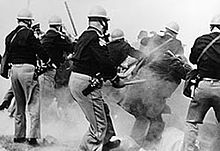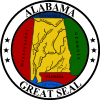The Alabama Portal Alabama (/ˌæləˈbæmə/ AL-ə-BAM-ə) is a state in the Southeastern region of the United States. It borders Tennessee to the north, Georgia to the east, Florida and the Gulf of Mexico to the south, and Mississippi to the west. Alabama is the 30th largest by area and the 24th-most populous of the 50 U.S. states. Alabama is nicknamed the Yellowhammer State, after the state bird. Alabama is also known as the "Heart of Dixie" and the "Cotton State". The state has diverse geography, with the north dominated by the mountainous Tennessee Valley and the south by Mobile Bay, a historically significant port. Alabama's capital is Montgomery, and its largest city by population and area is Huntsville. Its oldest city is Mobile, founded by French colonists (Alabama Creoles) in 1702 as the capital of French Louisiana. Greater Birmingham is Alabama's largest metropolitan area and its economic center. Politically, as part of the Deep South, Alabama is predominantly a conservative state, and is known for its Southern culture. Within Alabama, American football, particularly at the college level, plays a major part of the state's culture. Originally home to many native tribes, present-day Alabama was a Spanish territory beginning in the sixteenth century until the French acquired it in the early eighteenth century. The British won the territory in 1763 until losing it in the American Revolutionary War. Spain held Mobile as part of Spanish West Florida until 1813. In December 1819, Alabama was recognized as a state. During the antebellum period, Alabama was a major producer of cotton, and widely used African American slave labor. In 1861, the state seceded from the United States to become part of the Confederate States of America, with Montgomery acting as its first capital, and rejoined the Union in 1868. Following the American Civil War, Alabama would suffer decades of economic hardship, in part due to agriculture and a few cash crops being the main driver of the state's economy. Similar to other former slave states, Alabamian legislators employed Jim Crow laws from the late 19th century up until the 1960s. High-profile events such as the Selma to Montgomery march made the state a major focal point of the civil rights movement in the 1950s and 1960s. (Full article...) Entries here consist of Good and Featured articles, which meet a core set of high editorial standards.
Harry Toulmin (sometimes called Henry Toulmin) (April 7, 1766 – November 11, 1823) was a Unitarian minister and politician. The son of noted Dissenting minister Joshua Toulmin, Toulmin fled his native England for the United States after he and his followers were persecuted for their beliefs. He arrived in Virginia in 1793, and aided by recommendations from Thomas Jefferson and James Monroe, he was chosen president of Transylvania Seminary (now Transylvania University) in Lexington, Kentucky. His Unitarian views, however, offended many of the orthodox Presbyterian members of Transylvania's board of regents, and Toulmin resigned after two years. Shortly after his resignation, Toulmin was appointed Secretary of State of Kentucky by Governor James Garrard. He influenced Garrard – a Baptist minister – to adopt some doctrines of Socinianism, for which he was expelled from the local Baptist association, ending his ministry. As Secretary of State, Toulmin endorsed the Kentucky Resolutions and revised the state's code of laws in conjunction with Attorney General James Blair. After the expiration of his term as Secretary of State in 1804, Thomas Jefferson appointed him Superior Court Judge for the Tombigbee District of the Mississippi Territory. He was the first U.S. district judge to hold court on Alabama soil. As the highest-ranking authority in the large territory, he tried to prevent residents in his jurisdiction from conducting raids against the Spanish in West Florida and from participating in the Creek War between two rival factions of Creek Indians. When the state of Alabama was formed from part of Toulmin's district, he helped write the new state's constitution and was elected to the state legislature. Again, he was asked to compile a digest of the region's laws, which he completed in 1823. (Full article...)Selected article -The Selma to Montgomery marches were three protest marches, held in 1965, along the 54-mile (87 km) highway from Selma, Alabama, to the state capital of Montgomery. The marches were organized by nonviolent activists to demonstrate the desire of African-American citizens to exercise their constitutional right to vote, in defiance of segregationist repression; they were part of a broader voting rights movement underway in Selma and throughout the American South. By highlighting racial injustice, they contributed to passage that year of the Voting Rights Act, a landmark federal achievement of the civil rights movement. Since the late 19th century, Southern state legislatures had passed and maintained a series of Jim Crow laws that had disenfranchised the millions of African Americans across the South and enforced racial segregation. The initial voter registration drive, started in 1963 by the African-American Dallas County Voters League (DCVL) and the Student Nonviolent Coordinating Committee (SNCC) failed as local White officials arrested the organizers and otherwise harassed Blacks wishing to register to vote. The passage of the Civil Rights Act of 1964 legally ended segregation but the situation in Selma changed little. The DCVL then invited Rev. Martin Luther King Jr. and the activists of the Southern Christian Leadership Conference (SCLC) to amplify the efforts, and these figures drew more prominent people to Alabama. Local and regional protests began in January 1965, with 3,000 people arrested by the end of February. On February 26, activist and deacon Jimmie Lee Jackson died after being shot several days earlier by state trooper James Bonard Fowler during a peaceful march in nearby Marion. To defuse and refocus the Black community's outrage, James Bevel, who was directing SCLC's Selma voting rights movement, called for a march of dramatic length, from Selma to the state capital of Montgomery, calling for an unhindered exercise of the right to vote.[page needed] (Full article...)General images -The following are images from various Alabama-related articles on Wikipedia.
Did you know -
TopicsCategoriesNew articlesThis list was generated from these rules. Questions and feedback are always welcome! The search is being run daily with the most recent ~14 days of results. Note: Some articles may not be relevant to this project.
Rules | Match log | Results page (for watching) | Last updated: 2024-06-01 19:40 (UTC) Note: The list display can now be customized by each user. See List display personalization for details.
Related portalsWikiProjectsAssociated WikimediaThe following Wikimedia Foundation sister projects provide more on this subject:
Sources |


































































